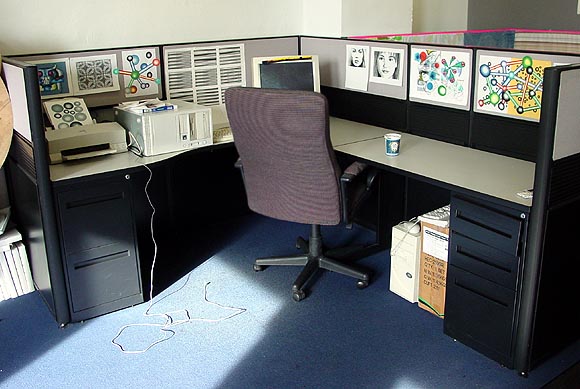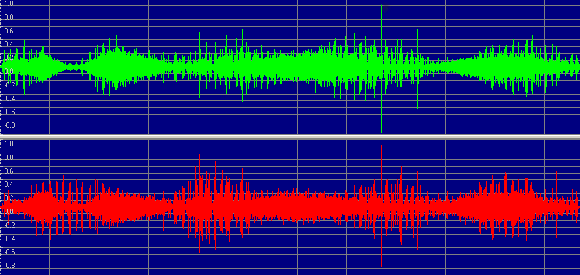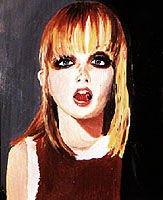View current page
...more recent posts
j asked if I was going to do sound-related work in connection with my upcoming performance piece of sitting in an office cubicle making art for
Yesterday one of the organizers politely but nervously asked me if I still have an, um, job these days. The answer is yes! Where I work now isn't so physically different from this "art project" and my past jobs; it is more demanding, though. We could talk about it, but let's just say blogging about my perma (as opposed to permatemp) gigs is not part of my long-term survival plan as an artist. (But

My cubicle for the ART*%@((WORK show described below. The moire pattern on the chair isn't me being deliberately psychedelic--it's a "digital camera error."
Opening in a few days is a show I'm in called "ART)@*!WORK" (the characters vary each time it's typed), taking place in a 16th floor office suite at 8th Ave and 36th Street. Artists in this group exhibition will do installations, etc., in the cubicles of this formica-heavy unrented space. The last tenant sold mobile phones or something (still checking on that--it wasn't what I originally posted). Here's how I'm describing my piece:
Tom Moody, "Office Reality: Channeling My Art Life from 1995-2000," performance work, 2005. Moody will keep "office hours" while the exhibition is open (Tues 9-5; Sun. 12-6 from May 10 to 31), and will sit and draw on an old computer. Portraits, abstract art, and tasteless cartoon imagery will be pinned up in his cubicle as he works. All will be drawn using MSPaintbrush (precursor to Microsoft Paint); Moody's attire will be "business casual."I should have photos of my "work space" up soon. Here's a summary of the press release:
ART*!(%WORK, 520 Eighth Avenue Between 36th and 37th Street. Suite 1602; opening reception with live performance by Irene Moon May 10 2005 7-9 p.m; regular "office" hours: Tuesdays 9-5 and Sundays 12-6
May 2005, New York City—Ignivomous, a non-profit arts organization dedicated to nurturing and developing new genres, art forms and mediums presents ART!@*<>WORK, an art exhibition exploring the tension between the art of doing work and the work of doing art.
This show will take place in the cubicles of a midtown Manhattan office space. Fifteen artists will transform and exhibit projects inspired by the act of doing work and the spaces created for working. Visitors will be invited to explore and interact with the space during "office hours."
ARTISTS' WORK INCLUDES: Cat Mazza (microRevolt) recreating corporate logos with knitting, machines, and needlepoint; Sabrina Gschwandtner sewing thread and paper drawings on the machine installed in her cubicle; LoVid and Douglas Repetto producing patchwork of videos generated by an installation of work clothes and electronic office supplies; Evan Greenfield and Erika Somogyi creating a shrine to lost free time out of Sculpey clay and wax; Tony Luib transforming his cubicle into an abstract environment using office supplies; Michelle Rosenberg’s installation will create a space for daydreaming; Yoav Bergner replacing the office’s furniture with his own artisan and conceptual furniture; Elana Langer installing an audio piece compiled of field recordings taken from local office spaces; N.I.N.E launching a new addition to their urban exploration game HERE "I Hate My Work"--visitors will be invited to take part in the game throughout the show; Irene Moon presenting a 4’ tall microscope as well as photographs and a video animation from her MS thesis in entomology; Brian Alfred will show a collage entitled Cubicles with a replication of all the tools used to make the work out of paper; Tom Moody installing an old computer and drawing during visiting hours portraits using the outdated software Paintbrush; Bengala will include their personal experiences from their jobs in a mixed media installation.
Hunter at DailyKos:
There are plenty of individuals in the world -- people of deep faith, regular churchgoers, etc. -- who see no conflict between faith and science. It requires significantly less imagination, if you are of both a scientific and a religious bent, to imagine the universe being set into motion through a single, unimaginably powerful spark of existence -- a singularity of time and space that gave birth to all that followed -- than it is to imagine the earth, heavens, animals, plants, elements, galaxies, fossil records, tectonic processes, quantum effects, etc., etc., etc., each being laid out one-by-one like props on a television set, all waiting to be set into motion at once when an unseen director cries action on the two poor unknowing saps gorging themselves at the buffet table. Science, as it turns out, requires that you believe in a much more powerful and ingenious God than the God of fundamentalist Topeka, Kansas.As the aliens say in Dark City: "Let the tuning commence!"

"Nice Curves" [mp3 removed]
I kind of hate to debate Damien Hirst here, because there are better artists who never get attention, but the current paintings at Gagosian do look more interesting in photographs than live so I'm quoting the following exchange from the comments as a public service. It's also "my position on Hirst," for what that's worth. Sally McKay said:
[T]here was another drug painted in the show [besides the Paracetamol reproduced here]--- I can't remember now, an antidepressent ...xanax? with yellow on the label. Anyhow, I saw slides of the show at a symposium and the woman next to me pulled my sleeve excitedly and said "I take that one!" We both gave a little "whoo-hoo" cheer from the cheap seats which mystified the rest of the audience a bit. Anyhow, I started seeing this show as a kind of greatest hits of contemporary apathy. I've been instructed already here and elsewhere as to how bad the paintings were. But Damien Hirst is such a cypher, I'm not satisfied just ascribing this crappy output to one guy having a bad idea. He's an institution, and if his art is coming out as lame crap then there's a cultural balloon floating lame crap that is worth trying to look at.And my reply:
Sometimes a cigar is just a cigar, and sometimes tossed-off paintings of "anomic" subjects are...
This is the third Gagosian show I've seen of Hirst's, plus the pieces in "Sensation" and a dramatic but poorly conceived museum show in Dallas, when he still just a lad. He is only a passable fabricator, with a knack for making work that almost always looks better in photos than in person. It was disappointing after experiencing the work of our own very thorough and meticulous bad boy Jeff Koons to see that Hirst's shark was held up inside the tank with cheap fishing line that sort of bites into the sagging creature, and that the sections of cut up cow were affixed to the insides of their vitrines with plastic safety ties. We Koons fans take it on faith that our guy would have figured out a way to make the former seem weightless and latter sandwiched tightly between glass surfaces, or he wouldn't have done the show (after all, he spent years working on a Guggenheim exhibit that never happened, legend has it, because he couldn't resolve certain fabrication issues). I gave Hirst a pass for ambition--we all do. But these paintings weren't ambitious, they were a retrenchment, a mere sellout disguised (in plain sight) as a fuck you, with what I would describe as textbook negative content (blood, check; gross organs, got em; media photos of woman on crack, oh yeah...).
Your "greatest hits of contemporary apathy" is a great line--hopefully someone will do that show someday.

This bit of unabashed, 40 years after the fact Pop Art is the best piece in Damien Hirst's painting show at Gagosian. The quality level/vibe of the rest of it is much like the canvases Ludwig Schwarz (and also an artist in Germany who's name I'm blanking on) did where they hired a company in China that will render any photo as a photorealistic oil. Hirst's contracted-out art is actually slightly more inept, hand-wise, than those guys'. The photos chosen were his typical death from life, life from death themes. He's having us on as usual, but also heading down the painting-on-canvas trail that many conceptualists follow to stay market-viable. Usually that's when they--sorry for the pun in Hirst's case--"jump the shark." (But of course Hirst has been producing paintings all along, clever bastard: the dots, which are kind of good, and the Walter Robinson-derivative spin paintings.) As joester points out on Sally McKay's page, the Gagosian set
...weren't painterly paintings. They had wiener symptoms (where every brush stroke looks like a wiener) and were really ugly to look at up close. Not ugly in a good way, ugly in a rushed "oh my god I have to paint 12 of these by wednesday" way.That's really all you need to know about the show. The work is too lame to merit any discussion of crack addicts, bloodied football hooligans, dissected brains, appropriation theory, and whatever else they they've raised. The forced "downer" themes also recall Cindy Sherman's vomit photos, an extended lament over the curse of success without end that attaches itself to "canonical" visual artists, more than any other type of creator (because we still have this medieval idea that art is iconic and forever, reinforced by a market that needs a canon). "I know--I'll make something they'll really hate." Except they don't hate it.

Karen Kilimnik: So much better than Elizabeth Peyton it's not even funny
Here are some quotes from a silly New York Times article today about the disparity in auction prices between male and female artists (thanks again, Bill):
One more example. Since three emerging figurative painters - Luc Tuymans of Belgium and the Americans John Currin and Elizabeth Peyton - were exhibited together at the Museum of Modern Art in 1997, they, too, have come to seem almost like classmates, all heralded as leading figures in painting's contemporary resurgence. [What resurgence? Painting left the art market for about two years in the mid-70s, it hasn't gone away since.] The two men's canvases have sold for more than $1 million. Meanwhile, Ms. Peyton's 1996 oil portrait of a languorous John Lennon is estimated by Christie's at $200,000 to $300,000. And even that is a lot more than the current record price for her work: $136,000, set in June 2002.This is great news. Perhaps there is a (benign, de-gendered) God, after all. Peyton's work is tepid and blandly illustrational: rather than languorous the paintings would be better described as fey, or wan, and that's all she does, fey and wan, over and over and over. Stupid looking people all with the same cherry red lips--how about some other colors for those? Karen Kilimnik's good bad paintings ca. 1997 would have been a better choice for that particular (overrated) MOMA show.
Art defies head-on comparison. Forget apples and oranges; how does one judge the value of [Rachel] Whiteread's cast fiberglass and rubber mattress relative to Mr. Hirst's deteriorating shark? Or of Maurizio Cattelan's sculpture of a taxidermied ostrich compared with [Agnes] Martin's canvas with the faintest of graphite grids on it? The contemporary art market has at least one frustratingly simple answer: price. And from that perspective, the comparison is unmistakable: art made by women is regarded less highly than art made by men.This argument is tautological: the art world chooses men over women in the competition for higher prices; choices can't be easily made; the only criteria for choosing is price. Art doesn't actually "defy comparison," people do it all the time, and usually not as ludicrously as above. You compare artist to artist, rather than arbitrarily chosen artwork to arbitrarily chosen artwork.
In all of the following comparisons (originally posed in the article), the former artist is protean, energetic, and innovative and the latter is refined, narrow-ranged, building on and deepening existing ideas, and sorry, we tend to value one more than the other: Philip Guston vs Joan Mitchell, Damien Hirst vs Rachel Whiteread, and (if you must compare these two) Mauricio Catellan vs Agnes Martin. Guerrilla Girl repellent: "Women can make art as well as men can. Many of the artists mentioned in the article are undervalued and the market will eventually correct for that, but on the basis of scholarship and consensus, not nitwitty New York Times articles that refuse to make meaningful comparisons."
